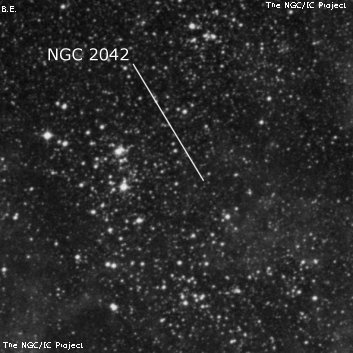
John Herschel discovered NGC 2042 = h2922 on 30 Dec 1836 and recorded "the chief star (9th mag) of a large, irregular figured, looped or hooked cluster of stars 12..15th mag, rich and various, and filling the field." His description and position applies to the assocation LH 89.
This object may have been discovered earlier by James Dunlop. His D181, described as a "small faint nebula, 10" or 12" diameter" is 5.5' NW of center of the association. But the description doesn't match an object of this size. His D 140, described as "a small faint round nebula" is a similar distance SW of center, but again the description is a very poor match. Finally D 183, described as "a faint ill-defined nebula, 20" diameter", is ~8' NE but another poor match in description. So, I'm not confident any of these observations referring to NGC 2042.
400/500mm - 18" (7/8/02 - Magellan Observatory, Australia): fairly large patch of stars and haze (association LH 89), ~5' in size. At least two dozen stars are resolved in an elongated group oriented SW-NE, including a few mag 10 stars over unresolved stars or outer nebulous haze from the Tarantula complex. Two additional knots are to the northwest and form an obtuse isosceles triangle with NGC 2042. The first knot is KMHK 1122 situated 5' NW and S-L 585 is 10' NW. NGC 2042 is located just 17' NW of the center of the Tarantula Nebula.
600/800mm - 25" (4/3/19 - OzSky): very large group of stars with unresolved haze (association LH 89), extending nearly 10' from north to south and contains a couple of knots of stars, a few dozen mag 12-14 stars, a mag 10.3 star at the west tip and numerous mag 15+ stars.
BRHT 16a, situated near the center, is a very bright knot near the center, ~10" diameter. A very faint star was resolved at the west edge.
KMHK 1122, on the north east side (2' NW of BRHT 16a), resolved into a 10" pair of stars at the center, encased in a very small glow. Several stars (mostly faint) were resolved nearby including two two mag 12.5 and 12.8 stars close east of the central pair and some mag 15 stars around the edges.
Notes by Steve Gottlieb